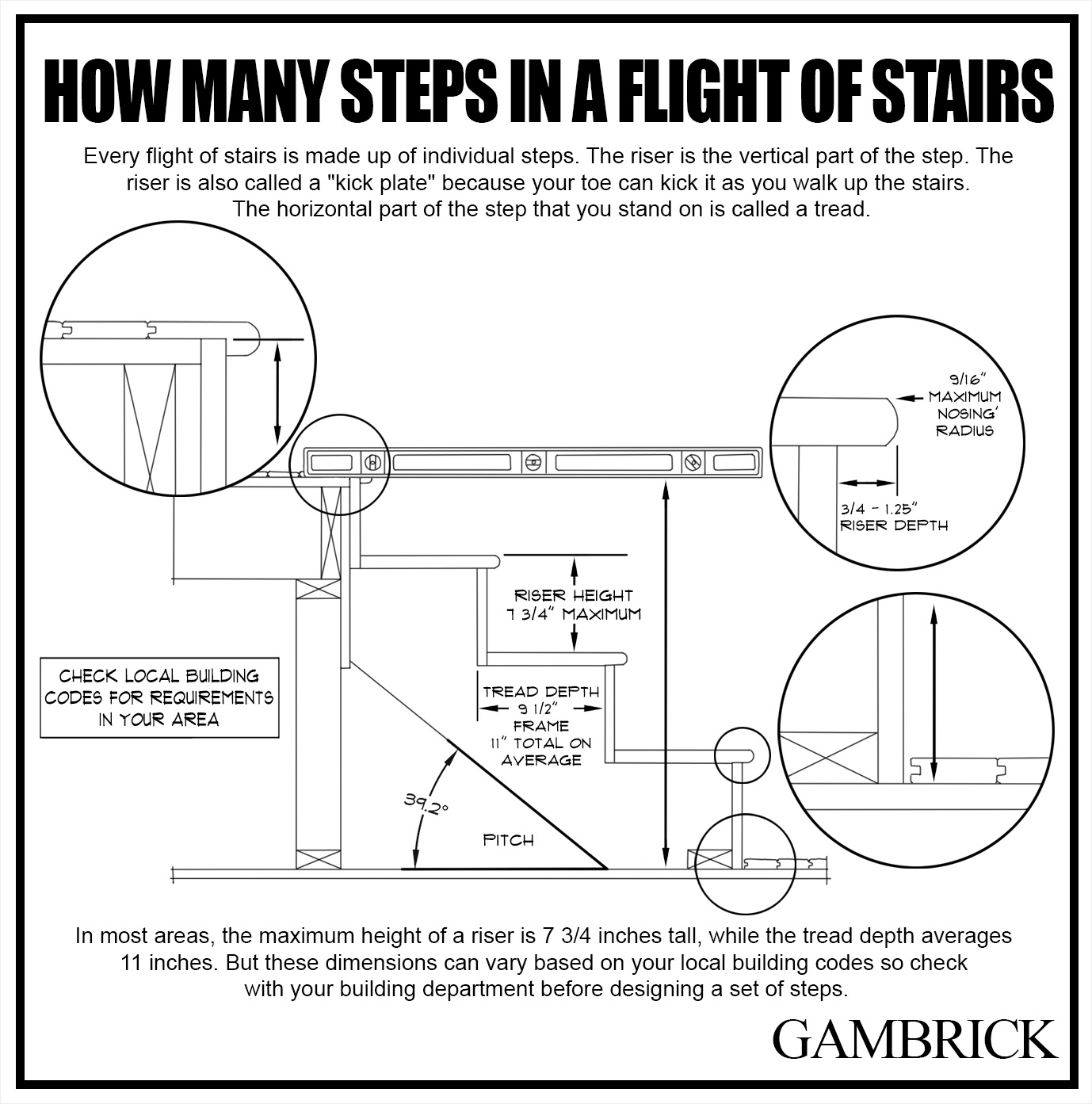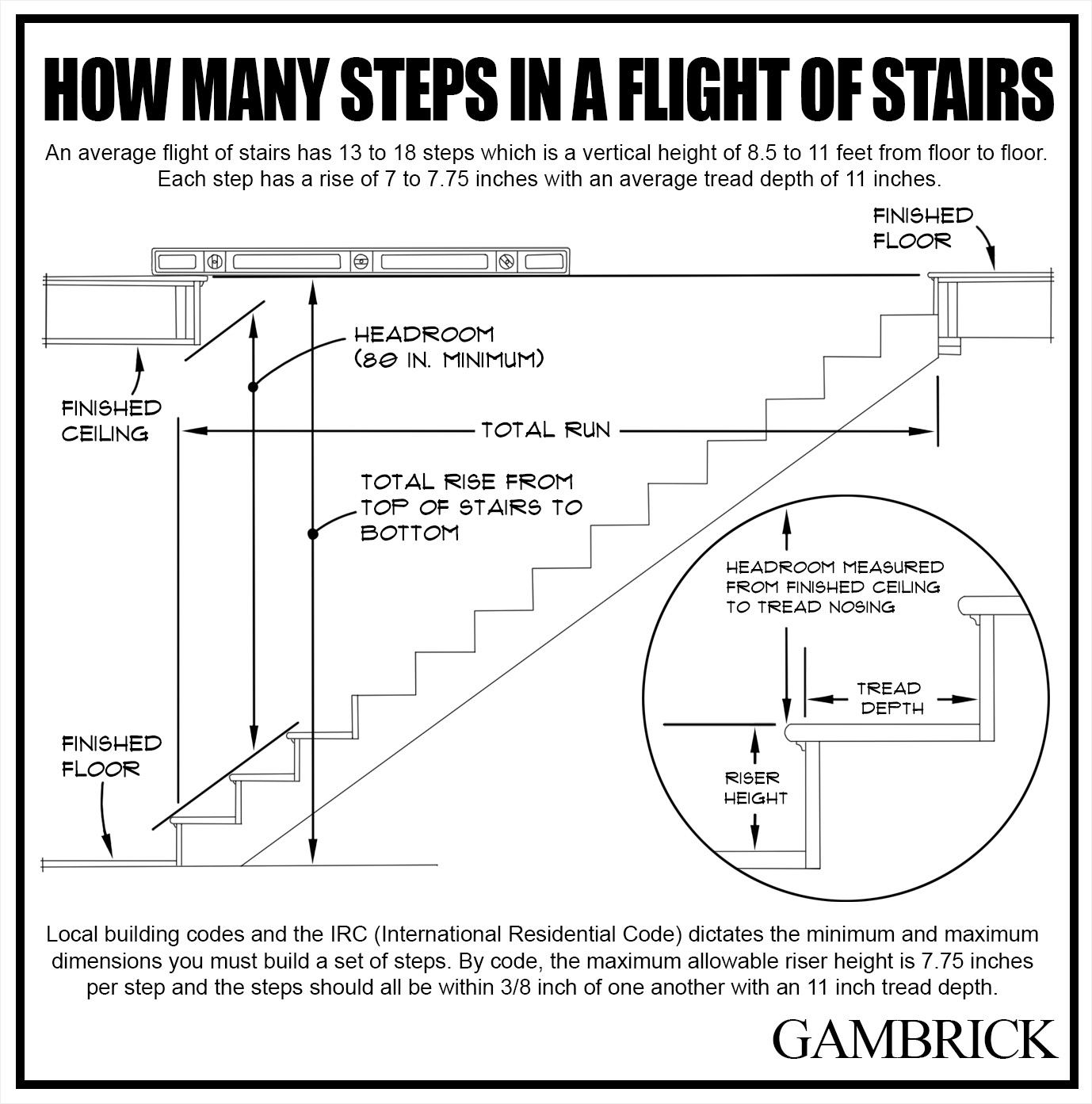How Many Steps In A Flight Of Stairs?
An average flight of stairs has 13 to 18 steps which is a vertical height of 8.5 to 11 feet from floor to floor. Each step has a rise of 7.25 to 7.5 inches with an average tread depth of 9.5 inches. Local building codes and the IRC (International Residential Code) dictates the minimum and maximum dimensions you must build a set of steps. By code, the maximum allowable riser height is 7.75 inches per step and the steps should all be within 3/8 inch of one another. Because of these rules, a house with an 8 foot ceiling has 13 to 15 steps per staircase on average. A house with 9 foot ceilings averages 15 to 17 steps per staircase. And a house with 10 foot ceilings has 17 to 19 steps per staircase on average.
Whether you’re building a new set of stairs or replacing an old set, it’s very important to understand how many steps are in a flight of stairs. A flight of stairs is defined as two or more steps between one floor or landing and the next. A staircase is designed to bridge the vertical distance between lower and higher levels by dividing it into smaller vertical distances called steps.
Even if your staircase is not continuous, meaning it has landings or turns, it’s still considered a single flight if all the steps are structurally connected.
As a custom home builder who’s personally designed and built dozens of staircases, I can tell you it’s extremely important to follow your local building and IRC codes.
How Many Steps In A Flight Of Stairs
A flight of stairs has 13 to 18 steps which is a vertical height of 8.5 to 11 feet measured from floor to floor. This is based on a ceiling height of 8 to 10 feet and a typical staircase design. Some Modern or spiral staircase designs have open risers with more steps per staircase. IRC (International Residential Code) specifies that a step can be no greater than 7.75 inches. This single rule is why a staircase has 13 to 18 steps for an 8 to 10 foot ceiling.
Your local building department and the IRC set guidelines and minimum requirements for steps. Be sure to follow them or your staircase will not meet code.
Proper stair design ensures you pass inspections and help prevent accidents and injuries.
What Is A Flight of Stairs?
A flight of stairs is two or more steps between one floor or landing and the next. A set of stairs bridges the vertical gap between a lower and a higher floor by dividing it into smaller distances. These smaller distances are called steps. However, even if your staircase is not continuous, meaning it has landings or turns, it may still be considered a single flight of stairs if all the steps are connected. This is the case with modern stairs that have turns and landings but are built on a single steel backbone.
The most common height for a flight of stairs is 8 feet which is 13 to 15 steps. This is because most homes have an 8 foot high ceiling.
Why Does The Number Of Steps Vary?
The number of steps a staircase has varies based on the ceiling height, the height of each step, the staircase design, how much horizontal space you have and the tread size. According to the IRC (International Residential Code), a step can be no higher than 7.75 inches. This means the higher the ceiling the more steps you’ll need.
Tread depth is another important consideration when designing a set of steps. The average step has a tread depth of 10 inches. This means the bottom step of an average 13 step staircase is 130 inches away from the top step horizontally. That’s almost 11 feet. Designing a staircase with lots of short steps means you push the bottom step another 10 inches away on average. With staircases like this you need a very large room, some landings and turns, or a spiral design.
The design of the staircase matters when determining how many steps it has. Some Modern and spiral staircase designs have lots of shorter 4 to 6 inch steps. This increases the number of steps per staircase by about 1/3rd.
If a set of steps has a landing, the landing counts as a step and has the same height as the other steps. For example, if a home has 8 foot ceilings with 13 steps and a center landing, each step, including the landing, is 7.38 inches tall.
Determining Steps By Ceiling Height
One of the biggest factors that determines how many steps your staircase has is the ceiling height. A set of steps vertically connects one floor to another. The IRC (International Building Code) stipulates that a step can be no more than 7.75 inches high. So the higher the ceiling, the more steps you need per staircase.
Even if your staircase is not continuous, meaning it has landings or turns, it’s still considered a single flight if all the steps are structurally connected. When designing a staircase, the landings are considered a step and must be no more than 7.75 inches high.
All your steps and landings should be the exact same height. By code you’re allowed to be 3/8th inch off, but I recommend framing all the steps exactly the same height. This reduces the chance someone trips and falls.
Below is a chart showing the average number of steps in a flight of stairs according to the ceiling height.
| Ceiling Height | Average Number of Steps | Step Height |
|---|---|---|
| 8 foot ceiling | 13 to 15 steps | 7.38 to 6.4 inches |
| 9 foot ceiling | 15 to 17 steps | 7.2 to 6.35 inches |
| 10 foot ceiling | 17 to 19 steps | 7.05 to 6.31 inches |
Average Vertical Height Of A Staircase
The average vertical height of a flight of stairs is between 9 to 11 feet. This is based on the ceiling height of a typical home. The total height of a set of stairs is measured from finished floor to finished floor. This includes the height of the ceiling/floor joists of the higher floor. For example, if you have an 8-foot ceiling with 2×10 floor joists, the total vertical height of your staircase will be around 9 feet. If you have a 10-foot ceiling, the total vertical height of the stair will be around 11 feet.
In some flights of stairs, the staircase is fastened to the wall frame one step down. This makes the upper floor the top step. If you build a staircase with this design, an 8 foot ceiling would have a staircase about 8 vertical feet high. You don’t have to add the height of the floor joists because the staircase is set one step height down.
Riser Height & Tread Depth
Every flight of stairs is made up of individual steps. The riser is the vertical part of the step. The riser is also called a “Kick Plate” because your toe can kick it as you walk up the stairs. The horizontal part pf the step that you stand on is called a tread.
In most areas, the maximum height of a riser is 7 3/4 inches tall, while the tread depth must be between 9 to 11 inches. But these dimensions can vary based on your local building codes so check with your building department before designing a set of steps.
Most building codes also require that all risers be the exact same height within 3/8 inch. They also allow for some variance on the first and last steps which accounts for different height finished flooring.
For example, many people install wood flooring on the first floor but carpet on the second. They have different heights so this would throw off the stair heights at the top and bottom of the staircase by about 1/4 inch. But this small difference is considered legal by code.
What Is The Average Step Height (Rise)?
The average step height for a flight of stairs is 7 to 7 1/2 inches. The maximum height allowable by code is 7 3/4 inches according to the IRC (International Residential Code). And the minimum is usually 4 inches. However it’s very rare to see step heights that small. Most Modern and spiral flights of stairs with short steps have a 5 to 6 inch rise per step.
What Is The Average Step Depth (Tread)?
The average step or tread depth on a flight of stairs is approximately 10 inches. Most building codes require a minimum tread depth of 9 inches but no maximum. However it’s very rare to build a set of steps with treads over 12 inches. Large treads make the steps harder to walk up a step at a time unless your extremely tall.
What Is The Average Step Width?
The average step width of a flight of stairs is 36 inches. This is required by the IRC (International Residential Code). A handrail can not extend more than 4 1/2 inches from the wall. The width of the step can be 31.5 inches wide when one handrail is used when measured from the edge of the handrail to the edge of the step. The width of the step can be 27 inches wide when two handrails are used when measured from the edge of the handrail to the edge of the opposite handrail.
Steps can be wider than 36 inches. However, when they get over 6 feet (72 inches) wide, many locations require a center hand rail.
Are Staircases With Landings Considered A Flight Of Stairs?
A flight of stairs can have a landing if the stairs, and landings, are all structurally connected. This is the case with modern flights of stairs that are built on a single steel backbone. The stairs can turn, spiral, be curved or have landings and are still considered a flight of stairs because they’re one connected piece.
Staircases with a landing are not considered a flight when they’re built in separate pieces. This is how house stairs are typically built. The first and second floor and landing are built first, then stairs are built to connect the floors to the landing. In this case, the stairs would not be considered a flight because they’re not structurally connected.
There’s no minimum or maximum number of steps needed to qualify it as a flight. However most are at least 8 to 10 feet tall which is the height of a typical floor.
A landing is a platform between multiple flights of stairs. They can be located anywhere along the path of a large staircase or where the stairs change direction. A staircase can have any number of landings, but one to two in a home are typical.
Stair landings are a good way to break up a long staircase or make a turn. For example, if you have a long 12 foot flight of stairs, you can build a center landing which breaks the stairs up into two 6 foot sections. In this case, both 6 foot sections would be considered their own flight.
What Impacts The Number Of Steps In A Staircase?
The number of steps in a staircase depends on a few key factors.
- Building code: Building code is the biggest factor that impacts how many steps a flight of stairs has. It determines the minimum and maximum dimensions of each step. For example, a step can be no higher than 7.75 inches tall and is usually at least 4 inches high.
- Aesthetics: It’s important to consider how a flight of stairs looks when determining how many steps it has.
- Shape: A flight of stairs can have a variety of shapes. They may be curved, straight, angled or spiral.
- Landings: Many flights of stairs have landings the break up a long flight into smaller section or make the stairs turn.
There are also codes for railings, banisters, railings, open risers and handrails. When you design a set of stairs and determine how many steps it has, don’t forget to factor in all the other building codes pertaining to staircases.
How To Calculate The Number Of Steps For A Staircase
Here’s how to figure out the number of steps you need to build a flight of stairs.
- Measure the height from finished floor to finished floor. This is the total rise or vertical height of your staircase. If you’re building a staircase in a new home measure from subfloor to subfloor.
- Divide the total vertical height by 7 3/4 inches which is the maximum height each individual step can be. Round to the nearest full number to get the total number of steps.
- Divide the total vertical height by the total number of steps to get each steps height.
- If you did the math correctly, your step height should be less than 7 3/4 inches.
Example: The total rise is 108 inches between floors measured from plywood floor to plywood floor. Divide 108 by 7.75, and you get 13.93. Round up to 14. Now divide 108 inches by 14 steps and you get 7.71 inches. This is the height each of the 14 steps needs to be.
On most staircases, the steps are set one step height down from the upper floor instead of being level with the floor. If this is how you build your steps, your staircase would have 13 steps.
If your staircase has a landing, the landing counts as a step and is also 7.71 inches tall.
When building a staircase, keep in mind the thickness of your finished flooring. In some cases, the flooring on the first and second floors are not the same. You can adjust the top and bottom stair height to compensate.
Other Building Code Requirements
Riser height and tread depth are important things to consider when designing and building a flight of stairs. But there are other building codes that pertain to stairs which you should also keep in mind. These include guardrails, handrails, balusters and open risers.
Guardrails, Balusters, Open Risers & Handrails
In most areas, you must install guardrails along all open sides of a staircase if they’re over two steps high. These guardrails should be at least 36 inches high and they cannot have gaps larger than 4 inches wide between balusters or wire.
Any handrails used should also meet code. For example, they need to be graspable and no more than 4 1/2 inches from the wall. I typically set mine 32 to 36 inches high.
If your steps have open risers, the gap can not be larger than 4 inches wide.
Headroom Clearance
Headroom clearance refers to the distance between the top of any tread to the bottom of the ceiling above it. This distance must be at least 6 feet 8 inches when measured from the edge of the step nosing for interior staircases with closed risers. For stairs with open risers or exterior stairs with closed risers, headroom must be at least 6 feet 6 inches.
The headroom requirement helps ensure there’s enough room to use the stairs without having to duck under a low ceiling.
Summary: How Many Steps In A Flight Of Stairs?
An average flight of stairs has 13 to 18 steps which is a vertical height of 8.5 to 11 feet from floor to floor. Each step has a rise of 7.25 to 7.5 inches with an average tread depth of 9.5 inches. Local building codes and the IRC (International Residential Code) dictates the minimum and maximum dimensions you must build a set of steps. By code, the maximum allowable riser height is 7.75 inches per step and the steps should all be within 3/8 inch of one another. Because of these rules, a house with an 8 foot ceiling has 13 to 15 steps per staircase on average. A house with 9 foot ceilings averages 15 to 17 steps per staircase. And a house with 10 foot ceilings has 17 to 19 steps per staircase on average.
Whether you’re building a new set of stairs or replacing an old set, it’s very important to understand how many steps are in a flight of stairs. A flight of stairs is defined as two or more steps between one floor or landing and the next. A staircase is designed to bridge the vertical distance between lower and higher levels by dividing it into smaller vertical distances called steps.
Even if your staircase is not continuous, meaning it has landings or turns, it’s still considered a single flight if all the steps are structurally connected.
As a custom home builder who’s personally designed and built dozens of staircases, I can tell you it’s extremely important to follow your local building and IRC codes.
If you have any questions or comments about how many steps are in a set of stairs, email any time.

























